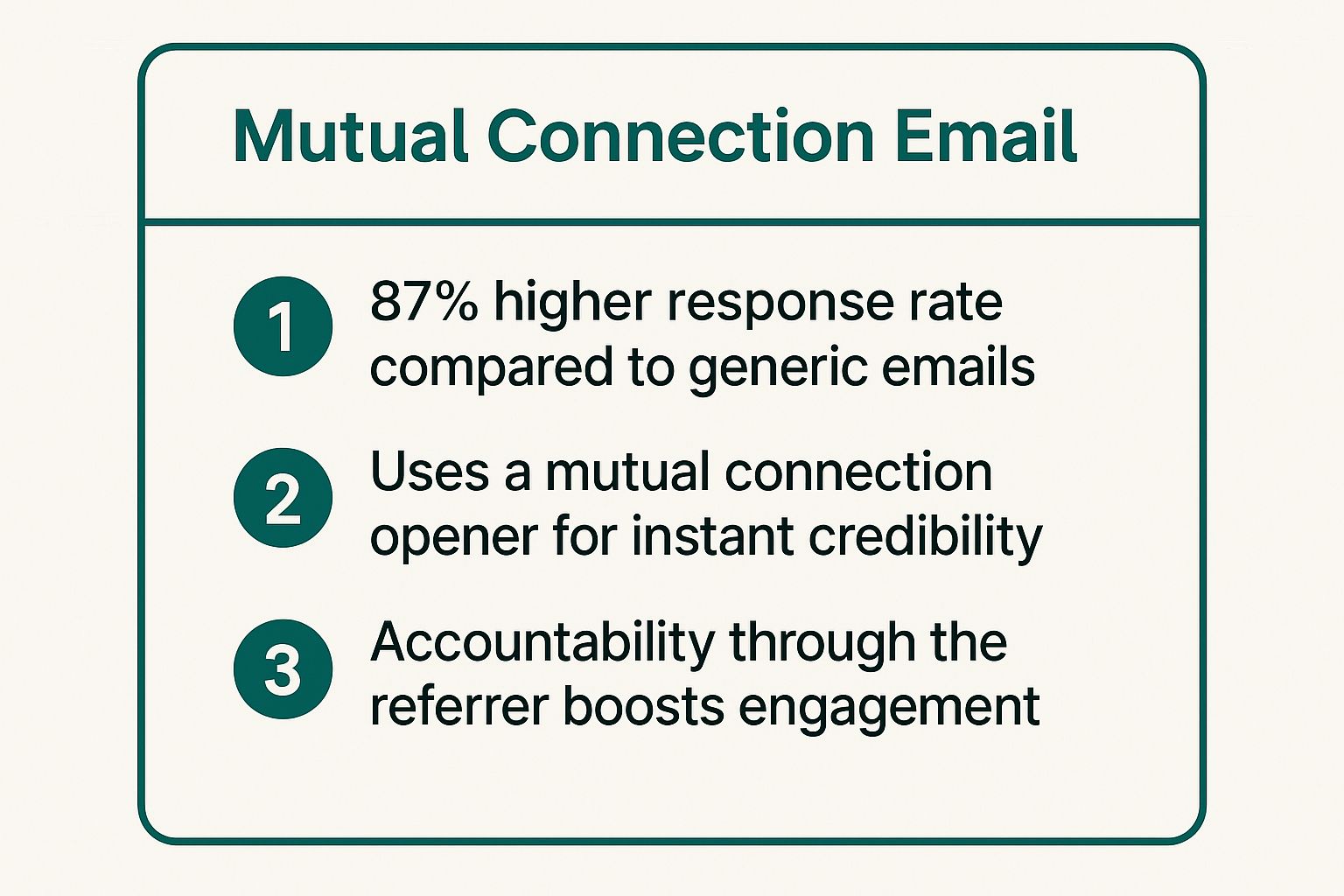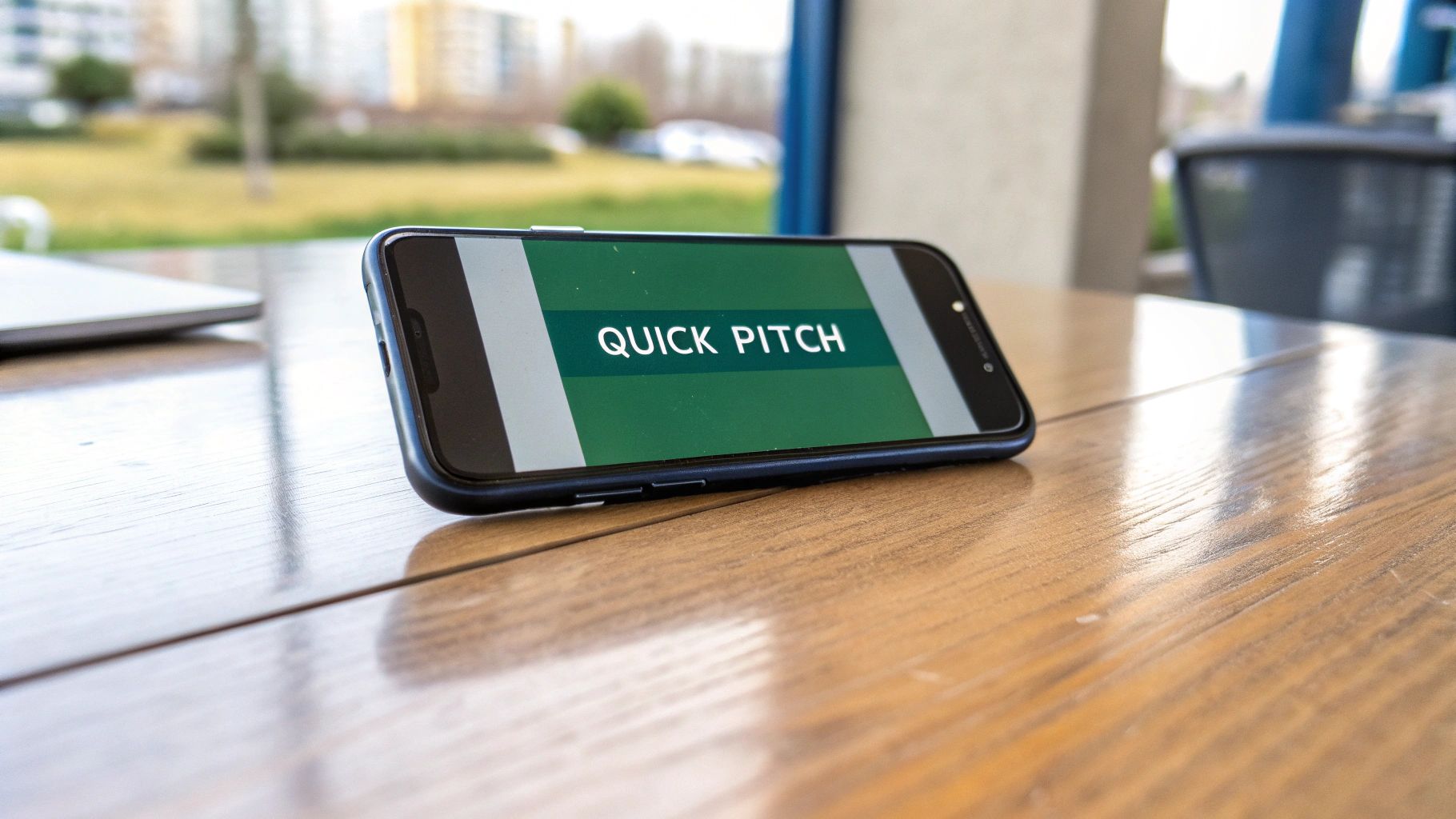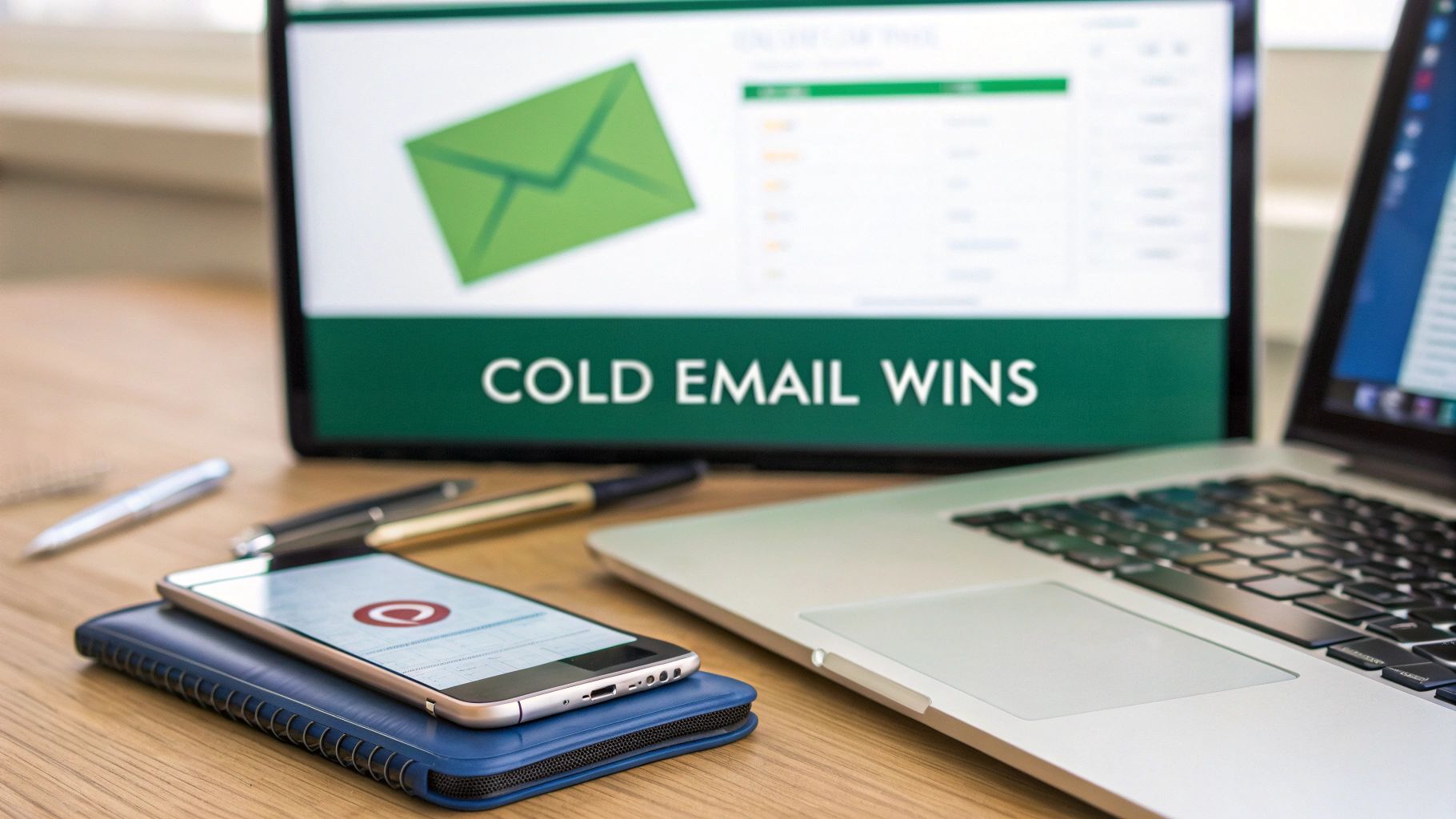Cold emailing often feels like shouting into the void. Despite the effort, an overwhelming majority of outreach emails are ignored, deleted, or marked as spam. The reason is simple: they lack personalization, fail to offer immediate value, and follow a generic, self-serving structure. They ask for time without first earning attention.
But what if you could craft emails that decision-makers actually want to read and reply to? It's not about a magic formula; it's about a repeatable method. This guide breaks down the proven strategies behind successful cold outreach, moving far beyond ineffective, copy-paste templates. We will dissect powerful examples of cold emails, exploring the psychology, structure, and specific tactics that make them work so effectively.
You won't just see what to write; you will understand why it works. We’ll analyze several distinct approaches, from leveraging mutual connections to providing value upfront. By the end, you'll have a replicable framework to not only find the right contacts but also to engage them meaningfully. This is how you turn a truly cold lead into a warm conversation, opening doors that were previously locked shut.
1. The Mutual Connection Email
Leveraging a shared connection is arguably the most effective way to transform a cold email into a warm introduction. This approach, often called a referral email, immediately breaks down the recipient's natural skepticism by borrowing credibility from a trusted mutual contact. Instead of being an unknown sender, you become a recommended professional, dramatically increasing your chances of getting a response.
The core principle is simple: social proof. When a prospect sees a familiar name, it triggers an immediate sense of obligation and curiosity. This is why it’s one of the best examples of cold emails for securing high-value meetings. The key is to get permission from your mutual contact first, ensuring the introduction is both genuine and expected.
Example Template & Breakdown
Here’s a practical template that puts this strategy into action.
Subject: Introduction from [Mutual Connection's Name]
Hi [Prospect's Name],
My name is [Your Name], and I'm the [Your Title] at [Your Company].
Our mutual connection, [Mutual Connection's Name], suggested I reach out to you. I was speaking with them recently about our work helping B2B SaaS companies streamline their lead qualification process, and they mentioned you were looking for innovative ways to improve your sales funnel efficiency.
At [Your Company], we developed a platform that automates [specific task], helping teams like yours cut down on manual data entry by up to 40%. Given your role as [Prospect's Title] at [Prospect's Company], I thought our approach might be relevant.
Would you be open to a brief 15-minute chat next week to explore if this could be a good fit?
Best,
[Your Name]
Strategic Analysis
- Immediate Credibility: The subject line and opening sentence instantly establish trust. Naming the mutual connection upfront ensures the email gets opened and read.
- Contextual Relevance: The email explains why the connection was made, linking the referrer's suggestion directly to the prospect's potential needs.
- Clear Value Proposition: It quickly pivots from the introduction to a concise and data-backed value proposition ("cut down on manual data entry by up to 40%").
- Low-Friction Ask: The call-to-action is a simple, time-boxed request ("brief 15-minute chat"), making it easy for the prospect to say yes.
Before you can send an email like this, you'll need the right contact information. If you're struggling to find verified addresses, you can discover more about how to find anyone's email address.
The following summary box highlights the key reasons this email strategy is so powerful.

As the data shows, the combination of a trusted referrer and the inherent accountability it creates makes this approach a top performer in any outreach campaign.
2. The Problem-Solution Email
This classic approach works by directly addressing a specific pain point the recipient likely experiences in their role. It demonstrates that you've done your research, understand their challenges, and have a relevant solution. By leading with empathy and insight, you immediately position yourself as a valuable consultant rather than just another salesperson.
The goal is to make the prospect feel understood. When you accurately diagnose a problem they are facing, it creates an instant connection and builds credibility. This is why it’s one of the most effective examples of cold emails for B2B SaaS, consulting, and marketing agencies, as it frames the conversation around value from the very first sentence.

Example Template & Breakdown
Here’s a template designed to pinpoint a specific business challenge.
Subject: A thought on improving [Prospect's Company]'s user onboarding
Hi [Prospect's Name],
I was reviewing the user journey for [Prospect's Company] and noticed that new sign-ups must complete a 7-step setup process. Based on our work with other SaaS platforms, we've found that multi-step onboarding flows like this can sometimes lead to a 30% drop-off rate before a user ever reaches the "aha!" moment.
At [Your Company], we help businesses like yours simplify this process. We recently helped [Similar Company] redesign their onboarding and they increased new user activation by 22% in the first month.
I have a couple of specific ideas for streamlining your flow that I’d be happy to share.
Do you have 15 minutes next Tuesday or Thursday for a quick call?
Best,
[Your Name]
Strategic Analysis
- Hyper-Specific Observation: The email opens with a precise, researched observation ("7-step setup process"). This proves you aren't just sending a generic blast.
- Problem Agitation: It quantifies the potential negative impact ("30% drop-off rate"), making the problem feel more urgent and tangible.
- Relevant Social Proof: The solution is introduced through a success story with a similar company ("increased new user activation by 22%"), making the value proposition credible and concrete.
- Value-First Ask: The call-to-action offers immediate value ("I have a couple of specific ideas… to share"), which incentivizes the prospect to agree to a meeting.
3. The Compliment and Question Email
Opening a cold email with a genuine compliment is a powerful way to disarm the recipient and demonstrate that you’ve done your homework. This approach immediately sets you apart from generic, mass-blasted emails by showing you value the recipient’s work. By following the praise with a relevant, insightful question, you create a natural bridge to a business conversation.
This method builds rapport before you ever make a pitch. The compliment must be specific and recent, such as referencing a recent company achievement, a well-written blog post, or a successful product launch. This authenticity makes it one of the most effective examples of cold emails for engaging busy decision-makers who appreciate being seen for their accomplishments.

Example Template & Breakdown
Here is a template demonstrating how to combine sincere praise with a strategic question.
Subject: Big fan of your recent [Achievement]
Hi [Prospect's Name],
I just wanted to say congratulations on your recent Series B funding. Scaling a tech company in this climate is incredibly impressive, and your team's work on [Specific Project or Product] is clearly paying off.
As you prepare to scale operations, I was curious how you're planning to maintain your award-winning customer support quality with a rapidly growing user base. It's a challenge many companies in your position face.
My team at [Your Company] specializes in helping post-funding SaaS businesses implement scalable customer success platforms without sacrificing personalization. We’ve helped partners like [Similar Company] reduce their ticket resolution time by 30%.
Would you be open to a quick 15-minute call next week to discuss some of the strategies we've seen work?
Best regards,
[Your Name]
Strategic Analysis
- Flattery with a Purpose: The email starts with a specific, timely compliment ("Series B funding") that feels genuine, not generic. This builds immediate goodwill.
- Insightful Question: The question ("how are you planning to maintain…quality") is thoughtful and directly ties their recent success to a common business challenge, positioning you as a strategic thinker.
- Pivots to Value: It smoothly transitions from the question to a solution-oriented value proposition, backed by a relevant data point ("reduce…resolution time by 30%").
- Problem-Aware CTA: The call-to-action offers a discussion around "strategies," which is more appealing than a generic sales pitch, making it an easy "yes" for a leader focused on growth challenges.
4. The Research-Heavy Personalized Email
In a world of automated outreach, demonstrating genuine effort is a powerful differentiator. This approach involves deep, specific research into the recipient's company, recent achievements, or public commentary. It proves you've invested time to understand their world before asking for theirs, immediately elevating your email from spam to a bespoke communication.
The goal is to move beyond generic compliments and connect your value proposition directly to a recent, relevant event. By referencing a specific podcast appearance, a company milestone, or a quote from an article, you create an undeniable and authentic hook. This makes it one of the most effective examples of cold emails for targeting high-value prospects or executives who are inundated with generic requests.
Example Template & Breakdown
Here’s a template demonstrating this highly personalized strategy.
Subject: Your recent interview on the "Growth Unpacked" podcast
Hi [Prospect's Name],
My name is [Your Name], and I'm the [Your Title] at [Your Company].
I was listening to your interview on the "Growth Unpacked" podcast last week and was really impressed by your point about the challenges of scaling customer support while maintaining a human touch. Your focus on proactive engagement over reactive ticket-handling is a philosophy we share.
At [Your Company], we help B2B tech leaders like you solve this exact problem. Our platform uses AI to identify at-risk customers and provides your team with actionable insights to engage them proactively, reducing churn by an average of 18%.
Given your priorities at [Prospect's Company], I thought our approach might resonate. Would you be open to a 15-minute call to discuss how we could help your team get ahead of customer issues?
Best,
[Your Name]
Strategic Analysis
- Ultra-Specific Hook: The subject line and opening sentence are hyper-personalized and timely, guaranteeing the prospect’s attention and demonstrating genuine interest.
- Intelligent Connection: The email doesn't just mention the research; it connects the prospect's stated challenge directly to the sender's solution, creating a logical bridge.
- Clear, Relevant Value: The value proposition ("reducing churn by an average of 18%") is concise and directly tied to the problem discussed in the podcast interview.
- Respectful Call-to-Action: The ask is low-commitment and frames the conversation around the prospect's already-stated goals, making it an easy "yes."
Before you can send an email this targeted, you'll need the right contact information to ensure it reaches the decision-maker's inbox. If you need help finding accurate addresses for key executives, you can discover more about how to find anyone's email address.
5. The Value-First Email
The Value-First email flips the traditional sales model on its head. Instead of asking for something, you give something away freely, positioning yourself as a helpful expert rather than just another salesperson. This strategy is built on the principle of reciprocity; by providing genuine value upfront, you create a positive impression and make the recipient more inclined to engage with you later.
This approach is highly effective because it disarms the prospect's natural defenses. You aren't pitching a product or requesting a meeting. You are simply sharing a valuable resource, like an industry report, a custom insight, or a helpful tool. This makes it one of the most powerful examples of cold emails for building long-term relationships and establishing thought leadership. The initial goal isn't a sale, but to become a trusted resource.
Example Template & Breakdown
Here’s a practical template that demonstrates how to lead with value.
Subject: A few thoughts on [Prospect's Company]'s content strategy
Hi [Prospect's Name],
I’m a big admirer of the work your team at [Prospect's Company] is doing, especially your recent [mention a specific project or piece of content].
As the [Your Title] at [Your Company], I spend a lot of time analyzing marketing trends in the [Prospect's Industry] space. I was looking at your main competitor, [Competitor's Name], and noticed they are gaining significant traction with video testimonials on LinkedIn.
I put together a brief, one-page document outlining three actionable video strategies that could help you capture some of that market share. It’s not a sales pitch, just some ideas I thought you'd find useful.
You can view the document here: [Link to resource]
Hope it helps!
Best,
[Your Name]
Strategic Analysis
- No Initial Ask: The email's power lies in what it doesn't do. It doesn't request a meeting or a call, which completely removes pressure from the recipient.
- Highly Personalized Value: The value provided isn't generic. It’s a customized insight based on research into the prospect's company and their direct competitors.
- Builds Authority and Trust: By offering free, expert advice, you immediately establish credibility and position yourself as a helpful authority in your field.
- Creates a "Reason to Follow Up": This email perfectly sets the stage for a future conversation. You can later follow up to ask what they thought of the insights, making the next email much warmer.
Crafting an email that provides value without selling can be a delicate balance. To perfect this approach, you can explore detailed guides on how to write cold emails that convert.
The following summary box highlights the key reasons this email strategy is so powerful.
As the data shows, leading with genuine helpfulness not only builds goodwill but also creates a foundation for future, more direct sales conversations.
6. The Broken Link Building Email
This strategy, a cornerstone of modern SEO, turns a website maintenance issue into a valuable opportunity. Instead of asking for something outright, you start by giving something valuable: a heads-up about a broken link on their website. By identifying a non-functioning link on a prospect's page, you create an immediate opening to offer your own relevant content as a superior replacement.
The principle here is reciprocity. You provide a helpful fix for their website, which makes them far more likely to consider your suggestion. This approach is one of the most effective examples of cold emails for content marketers and SEO specialists looking to earn high-quality backlinks, as it solves a real problem for the recipient while achieving your goal.
Example Template & Breakdown
Here is a template that demonstrates how to execute this technique effectively.
Subject: Broken link on your [Page Title] page
Hi [Prospect's Name],
I was doing some research on [Topic] today and came across your excellent article: [Link to Their Article].
I noticed that the link pointing to "[Anchor Text of Broken Link]" is no longer working and leads to a 404 error page. It's the one that originally pointed to this URL: [Dead URL].
I actually just published a comprehensive guide on a similar topic: [Link to Your Content].
It might make a great replacement for the broken link, and I thought it could be a helpful resource for your readers.
Either way, hope this helps you clean up the page!
Best,
[Your Name]
Strategic Analysis
- Value-First Approach: The email immediately offers value by pointing out a technical issue. This positions you as a helpful expert rather than a self-serving marketer.
- Specific and Actionable: It clearly identifies the exact location of the broken link and the dead URL, making it easy for the website owner to verify and fix.
- Seamless Pivot: The transition from identifying the problem to suggesting a solution (your content) is natural and non-aggressive.
- No-Pressure CTA: The call-to-action is soft. By framing the suggestion as a helpful option, you reduce friction and avoid sounding demanding, which increases the likelihood of a positive response.
This video from Ahrefs provides a great visual walkthrough of the broken link building process.
By leading with a helpful gesture, this type of cold email builds goodwill and dramatically increases your chances of securing a valuable backlink.
7. The Short and Direct Email
In a world of overflowing inboxes, brevity is a superpower. This minimalist approach respects the recipient's time by getting straight to the point in two or three sentences, making it one of the most effective examples of cold emails for reaching busy executives and decision-makers. It cuts through the noise by eliminating fluff and focusing on a single, compelling idea.
The core principle is to trade elaborate introductions for immediate value. By condensing your entire pitch into a powerful, data-driven statement and a simple call-to-action, you make it incredibly easy for the recipient to understand your offer and make a quick decision. This high-impact, low-friction method is designed for a fast 'yes' or 'no', maximizing efficiency for both parties.

Example Template & Breakdown
Here is a template that embodies the short and direct philosophy.
Subject: Quick question about [Prospect's Company]
Hi [Prospect's Name],
My name is [Your Name]. I help [industry] companies like yours reduce customer acquisition costs by up to 25% using a proprietary data enrichment framework.
Would you be open to a 15-minute call next week to see how we do it?
Best,
[Your Name]
Strategic Analysis
- Radical Brevity: The email is extremely short and can be read and understood in under 10 seconds. This respects the recipient's time and increases the likelihood of a response.
- Punchy Value Proposition: It leads with a specific, quantifiable outcome ("reduce customer acquisition costs by up to 25%"). This immediately answers the "what's in it for me?" question.
- Laser-Focused Ask: The call-to-action is a simple, singular request for a brief meeting. There are no confusing options or multiple links, making the next step clear.
- Low Cognitive Load: By removing unnecessary details, the email makes it easy for the prospect to process the information and decide whether to engage.
This direct approach relies on having the correct contact information to ensure deliverability. To improve your campaign's success rate, you should understand the importance of email address verification.
The following summary box highlights the key reasons this email strategy is so powerful.
| Strategy | Key Benefit | Best For |
|---|---|---|
| Brevity | Respects recipient's time, boosts replies | Busy C-level executives, decision-makers, and high-volume outreach |
| Direct Value | Communicates ROI immediately | Products/services with a clear, quantifiable benefit |
| Simple CTA | Makes it easy to say yes | Securing initial meetings, gauging interest, and starting conversations |
| Confidence | Projects authority and self-assurance | Sales professionals and founders who are confident in their offering |
As the data shows, the combination of a concise message and a clear value proposition makes this approach a standout performer for professionals who value efficiency.
7 Cold Email Types Comparison
| Email Type | Implementation Complexity | Resource Requirements | Expected Outcomes | Ideal Use Cases | Key Advantages |
|---|---|---|---|---|---|
| The Mutual Connection Email | Medium | Requires research on network | Higher open and response rates, instant trust | When shared connections exist | Builds credibility quickly, lowers spam risk |
| The Problem-Solution Email | Medium to High | In-depth industry research | Demonstrates expertise, creates urgency | B2B outreach with clear pain points | Highly relevant, easy to personalize at scale |
| The Compliment and Question Email | Medium | Significant research time | Positive impression, encourages dialogue | Building rapport and low-pressure sales | Creates genuine interest, fosters conversation |
| The Research-Heavy Personalized Email | High | Extensive detailed research | Extremely high relevance and credibility | High-value prospects with big deals | Shows serious intent, reduces spam perception |
| The Value-First Email | Low to Medium | Content creation | Builds goodwill and trust, long-term relationships | Brand building and awareness efforts | Low pressure, positions sender as helpful |
| The Broken Link Building Email | Medium | Technical SEO and link tools | High success in link-building, mutual benefit | SEO/content marketing | Immediate value, builds industry relationships |
| The Short and Direct Email | Low | Minimal | Quick reads, higher engagement | Busy executives and decision-makers | Concise, confident, easy to respond to |
From Template to Triumph: Your Next Steps in Cold Email Mastery
We’ve navigated through a diverse landscape of cold email strategies, from leveraging mutual connections to offering upfront value and conducting deep-dive research. The common thread weaving through all these powerful examples of cold emails is not a magic formula but a fundamental mindset shift: from sender-centric broadcasting to recipient-focused conversation starting.
The goal was never to hand you a script to copy and paste. Instead, these templates are strategic frameworks, blueprints you can deconstruct and rebuild to fit your unique voice, industry, and prospect. The most successful cold outreach is born from this process of adaptation, not blind adoption.
Your Action Plan for Effective Outreach
True mastery comes from implementation and refinement. Moving forward, focus your efforts on these three critical pillars:
-
Personalization with Purpose: Ditch generic compliments and surface-level observations. The Research-Heavy and Compliment-and-Question examples demonstrate that powerful personalization connects your solution directly to a specific, observable detail about their work, a recent company achievement, or an articulated challenge. Your research should always serve the purpose of building a relevant bridge to your value proposition.
-
Strategic Variability: Don't become a one-trick pony. The Short and Direct email works wonders on a busy C-level executive, while the Value-First approach is perfect for building trust with a technical manager. Your ability to choose the right strategy for the right audience is what separates amateurs from professionals. Use these examples as a menu of options, not a single recipe.
-
Ruthless Iteration: Your first cold email campaign will not be your best. Your tenth will be better, and your hundredth will be a finely tuned machine. Track your open rates, reply rates, and positive response rates. Test subject lines, opening sentences, and calls to action relentlessly. Every email you send is a data point that can inform a more effective strategy tomorrow.
Ultimately, the power of a great cold email lies in its ability to make the recipient feel understood and respected. It signals that you’ve done your homework, you value their time, and you have a genuine reason for being in their inbox. This is how you transform a cold lead into a warm conversation and, eventually, a valuable partnership. The journey from template to triumph is paved with genuine curiosity, strategic thinking, and a commitment to continuous improvement.
Ready to ensure your perfectly crafted emails land in the right inbox? The best templates in the world are useless if they never get delivered. Use EmailScout’s powerful email finder and verification tools to get accurate, up-to-date contact information, so your strategic outreach always reaches its target. Start finding verified emails today with EmailScout.
